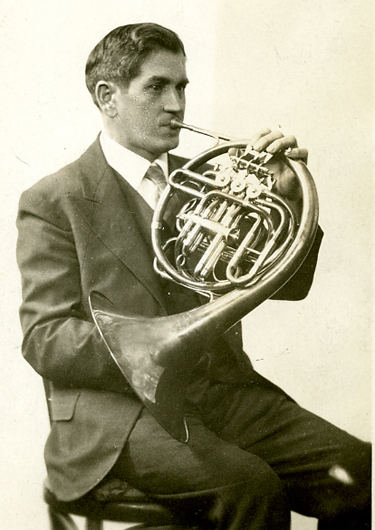.
(click on photos for larger view) |
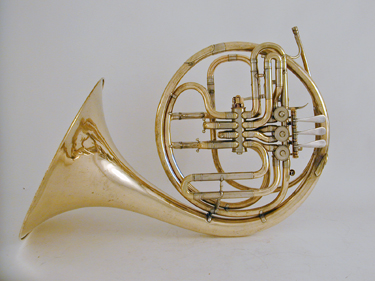
|
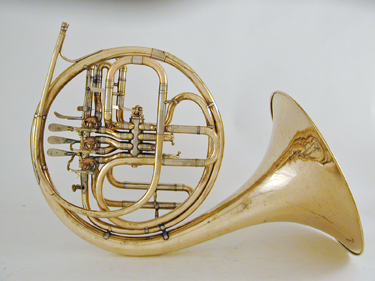
|
The compensating double horn by Carl
Lehman & Co. shown above is a fine example
of a "walzen" horn. The term "walzen" (German for
roller, barrel, or drum) describes the large
rotary change valve in the center of the horn. The
horn dates from about 1925 and the label (below)
states that patents are pending in Germany and foreign
countries. 1
|
31
St.L.
Carl Lehmann & Co.
Hamburg
Patent Doppelhorn
DRP
Auslandpatente ang
|
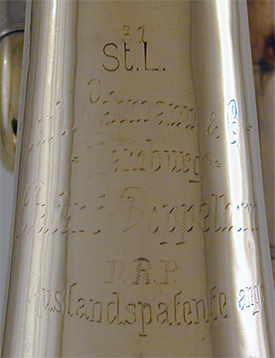
|
|
|
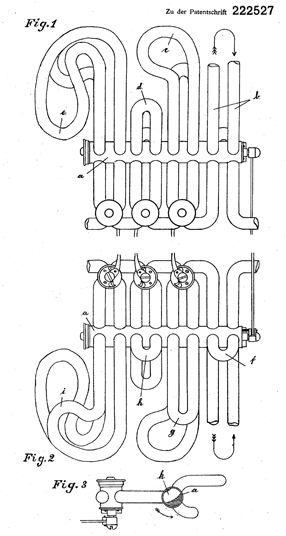
Otto Tiedt, DRP
222527, 1909
|
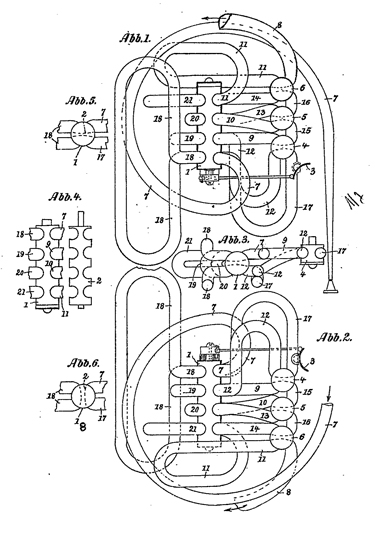
Lehman and Chemnitzer, DRP
440308, 1925
|
On April 29, 1909 Otto Tiedt
received Deutsches
Reich Patent 222527 for Doppelblechblasinstrument,
entstanden durch Vereinigung zweier
Instrumente verschiedener Stimmung in einem
Instrument (Double brass wind instrument,
created by combining two instruments of
different keys into one instrument, diagram
above left). 2 This a full double horn with
three single valves and one eight-story
("Walzen") change valve, operated by the thumb.
The single valves are connected to the change
valve through six parallel tubes. The two ports
for each slide are arranged side-by-side along
the length of the change valve which switches
between the F and B♭ slides. The two other
"stories" are for the F extension. The rotor of
the change valve turns 120 degrees between the
two sets of full-length F and B♭ slides. The
advantage of this design over a full double horn
is the lighter touch of single-story main valves
instead of the two-story valves of the typical
double. The disadvantages are that the second
valve slide of the B♭ side is too short to be
pulled for tuning, and the leverage and weight
of the massive change valve rotor. Nevertheless,
this valve was used on horns, trumpets, and
tubas as shown in the C.A. Wunderlich Catalog,
ca. 1935 (see below, left).
|
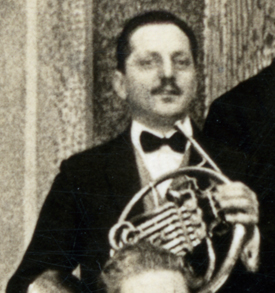
Unidentified player in unidentified
chamber orchestra with a Tiedt model horn
probably by C.A. Wunderlich (see catalog
illustration below, left).
|
|
Sixteen years after Tiedt's patent, Carl
Lehmann and Erdmann Chemnitzer received
the patent for the change valve on the horn shown at
the top of this page. As on the Tiedt horn the
main valves are single (one-story) rotors. Unlike
Tiedt's patent, however, this valve is for a
"compensating" double horn. The ports are arranged on
opposite sides of the instead of side-by-side, so it
is only a four-story valve, half the length of the
Tiedt valve (see diagram above right). In this design
the B♭ slides are located between the main valves and
the change valve, with additional "compensating"
slides for the F horn on the opposite side of the
change valve. The change valve adds proportional
supplemental tubing to the B♭ slides. One advantage of
a compensating horn is its lighter weight since tubing
is shared between the F and B♭ slides. In
comparison to the Tiedt change valve the rotor is also
much lighter and only has to rotate ninety degrees. In
addition to Carl Lehman & Co. horns of this design
were also produced by the firms August Knopf3,
Joesf
Lidl, and other makers.
 Zeitschrft für Instrumentenbau,
February 2, 1930
Zeitschrft für Instrumentenbau,
February 2, 1930
On November 21, 1929 Kurt August Knopf
received Gebrauchsmusterschutz
(D.R.G.M.) 1099255 for a compensating double horn
having a the usual three single valves, plus a
fourth single valve coupled to a three-story
walzen change valve (see the notice above and
catalog illustration below right). The fourth
valve replaces the fourth story of the
Lehmann/Chemnitzer valve that switches the
F-extension. According to Heyde this was a rather
well-known Knopf model until 1945 but, since the
switching was a little hard, it gradually fell
into disuse after World War II. In the ultimate
modification of the Lehmann/Chemnitzer model, August
Dummuscheidt in Frankfurt (Main) received a
patent ( DRP
518837, May 11, 1930) for a compensating
horn in which the walzen valve is replaced
entirely with four single valves connected in
tandem. In another variation, the Gebroeders
De Prins in Anvers, Belgium patented and
built the " Radio
Wonder Hoorn" in which the three piston
valves operated by a series of levers replace the
single rotary valves. It is a compensating horn
with the Lehmann/Chemninzer change valve.
Chistopher
Cornford has developed with Peter
Steidle a compensating triple horn, which is
marketed under the name: Mod. 3 S, incorporating a
four-story Lehmann/Chemnitzer valve.
|
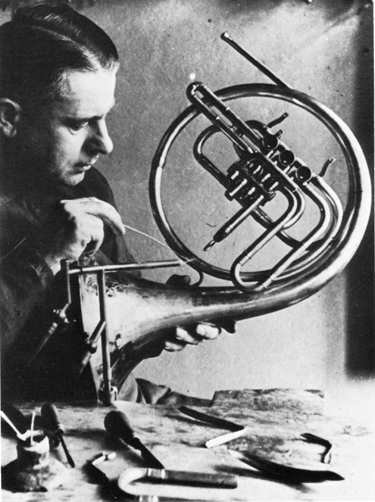
Herbert Fritz Knopf assembling a Model III
|
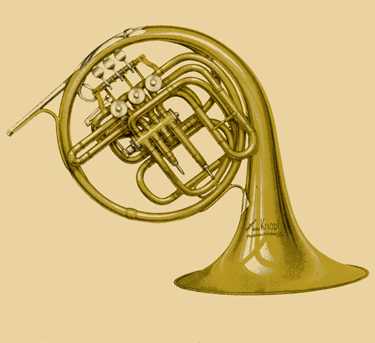
Doppelhorn, Model III, in F-B oder B-F
ineinander kombiniert gebaut, mit einfacher Maschine
und langen Umschaltventil. Compare the above
catalog illustration with the one shown below.
|
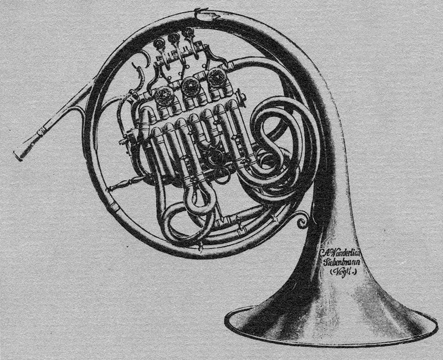
Wunderlich based on Tiedt patent
|
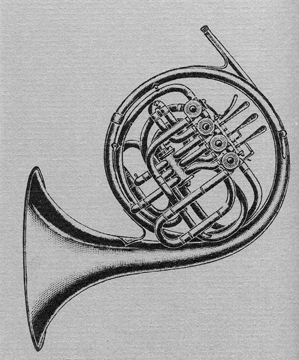
Knopf Catalog, ca. 1934
|
|
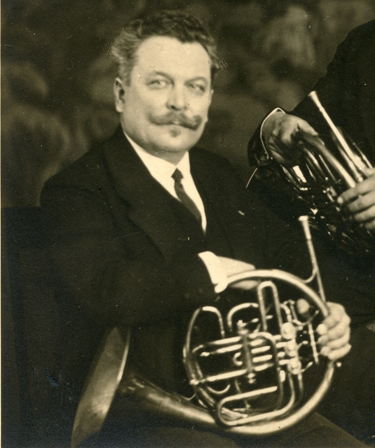
Josef
Suttner (1935)
|
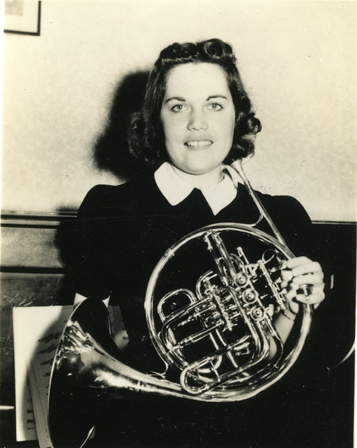
Helen
Enser (ca.. 1935)
|
Three variations on the Lehmann Walzen horn
are shown here. The horn that Josef
Suttner (above left) is holding a Walzen horn
probably made by August Knopf. Helen Enser
(above right) is holding a slightly different version
probably by another maker, and her teacher and good
friend of Suttner, Josef
Franzl (right), is holding yet a third slightly
different version, although the over-the-top valve lever
linkage appears to be the same as that shown in the
Knopf catalog illustration show above.
Below left, album cover of Josef Hobik, former
principal horn in the Czech Philharmonic, Prague Radio
Symphony, and Prague National Theatre Opera
Company. Below right, the dust cover of Robin
Gregory's excellent book shows a Walzen horn. It is not
identified in the text but appears to be the "Acustic"
model by Josef Lidl.
|
|
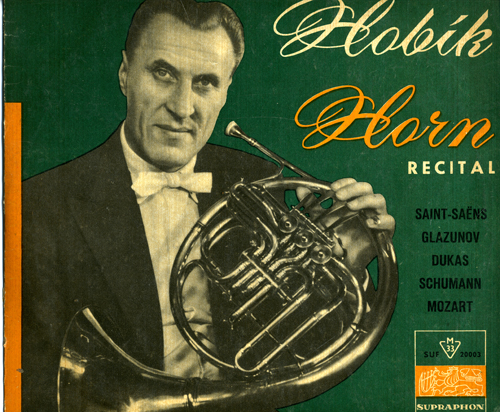
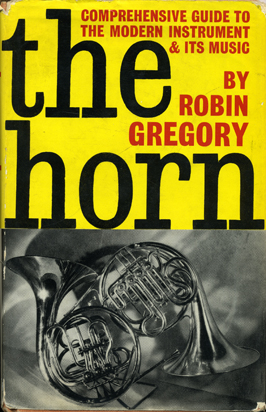
|
|
|
|








